There are more than 60 diseases linked to bird droppings, feathers, and infected birds’ fluids. This shows why it’s critical to act fast when birds infest your roof. Because birds can cause health risks and major damage, homeowners must take action to avoid these problems.
Key Takeaways
- Birds nesting in roofs can transmit over 60 zoonotic diseases through their droppings, feathers, and secretions
- Elderly, young, and immunocompromised individuals are at higher risk of serious infections like cryptococcosis, psittacosis, and histoplasmosis
- Nesting materials can clog gutters, damage roofing materials, and pose fire hazards in attics
- Prompt identification and professional removal of bird nests is crucial to address the issue effectively
- Implementing long-term deterrents and preventative measures is key to keeping birds from returning
This guide offers expert advice and practical methods for removing birds from your roof and stopping them from nesting again. We’ll discuss the risks birds bring, how they damage homes, and steps to take for a bird-free roof.
Introduction: The Problematic Presence of Birds Inside Your Roof
Birds nesting in your roof can cause many issues for homeowners. They bring health risks like diseases and can damage your home. It’s important to deal with birds under your roof or in your attic right away.
Overview of the Challenges Posed by Birds Nesting Within Roof Spaces
Birds in your roof create several problems such as:
- Potential transmission of zoonotic diseases through bird droppings and feathers
- Respiratory illnesses caused by exposure to contaminated dust and debris
- Blockages in gutters and drainage systems, leading to water damage
- Damage to roofing materials from the acidic nature of bird droppings
- Fire hazards posed by the accumulation of nesting materials
Importance of Addressing the Issue Promptly and Effectively
Dealing with birds in your roof quickly is key. It stops problems from getting worse. By acting early, you can avoid major damage, health issues, and expensive fixes. It’s crucial to keep your house safe and its structure strong.
“The UK has a breeding bird population of over 84 million pairs, highlighting the significant presence of birds in the country.”
Health Risks Associated with Birds in Your Attic
Birds in your attic are not just a nuisance; they bring health risks. Their droppings and feathers can spread diseases to humans. If ignored, these illnesses can be serious. Breathing in contaminated dust from bird nests can also cause respiratory problems.
Zoonotic Diseases Transmitted through Bird Droppings and Feathers
Over 60 diseases can be linked to birds, and some come from their droppings and feathers. These illnesses can be very harmful. Below are a few examples:
- Salmonellosis can cause food-poisoning symptoms like fever and diarrhea.
- Cryptococcosis is a fungal infection that can be serious.
- Histoplasmosis is a respiratory disease that can be life-threatening.
Respiratory Illnesses Caused by Exposure to Contaminated Dust
The risk doesn’t stop at zoonotic diseases. Bird nests can also worsen respiratory health. Their droppings and nesting materials create dust full of allergens and irritants. This can make asthma or allergies worse. Long-term exposure might cause or aggravate these conditions.
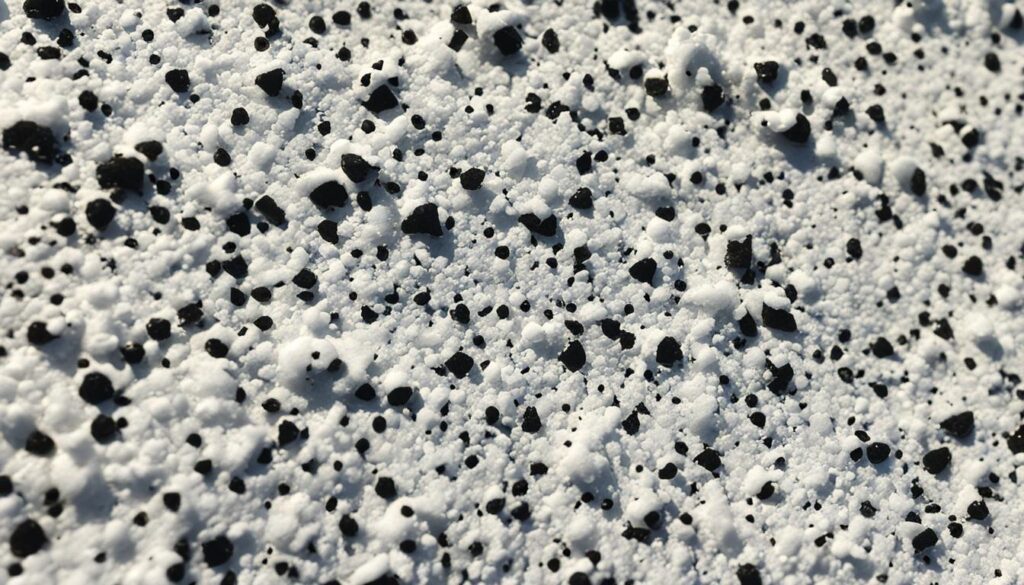
“Birds can remain in an attic for three to four months, and their droppings and feathers can pose serious health risks if not properly addressed.”
Taking care of bird nuisances is key to protecting your health. Enlisting professional help for removal is the safest choice. It’s about safeguarding your family’s health.
Structural Damage Caused by Birds Nesting in Your Roof
Birds nesting in your roof can be bad news. It can lead to serious structural damage in your home. Issues like clogged gutters and damaged roofing can occur. This problem needs to be fixed fast.
Blockage of Gutters and Drainage Systems
Birds often block gutters and drains with their nests and waste. This can cause water to pool and seep into the roof. It leads to rot, mold, and can damage your home’s foundation.
Damage to Roofing Materials from Acidic Bird Droppings
Bird droppings are acidic and can harm your roof. They can make materials weaken, leading to leaks and cracks. The stains and mess from the droppings also make your home look bad.
Fire Hazards Posed by Nesting Materials
The materials birds use for nests are flammable. If they build up in your roof, they can be a fire risk. It’s important to remove these materials to keep your home safe.
It’s key to prevent and address bird nesting in your roof. This can save your home’s value and keep your family safe. Regular checks, cleaning, and using bird deterrents are effective measures.
“A single pigeon can produce 25 pounds of fecal matter each year. When in flocks of 100 or more, bird droppings can accumulate quickly, compromising a building’s structure.”
Identifying Signs of Birds in Your Roof
Watching for signs of birds in your roof is key. They look for shelter and build homes in the safety of our roofs. So, it’s important to spot their presence early on. There are several signs that can give them away.
Concentrations of Bird Droppings
One clear sign is the gathering of bird droppings. If you see big piles of whitish droppings around, birds might have made a home there. These droppings are not just a mess. They can also be bad for your health.
Nesting Materials and Feathers
Seeing twigs, leaves, or feathers on your roof can also mean birds are there. Birds use these materials to build their nests. You might find feathers, signs the birds have started nesting.
Audible Cues
If you hear birds in your attic, they very likely are. Listen for sounds of nesting, like chirps and flapping wings. These sounds can help you find where they are.
Being alert to these signs helps you deal with bird issues early. By tackling the problem now, you prevent it from getting worse. Keeping your roof bird-free keeps your home safe and in good shape.
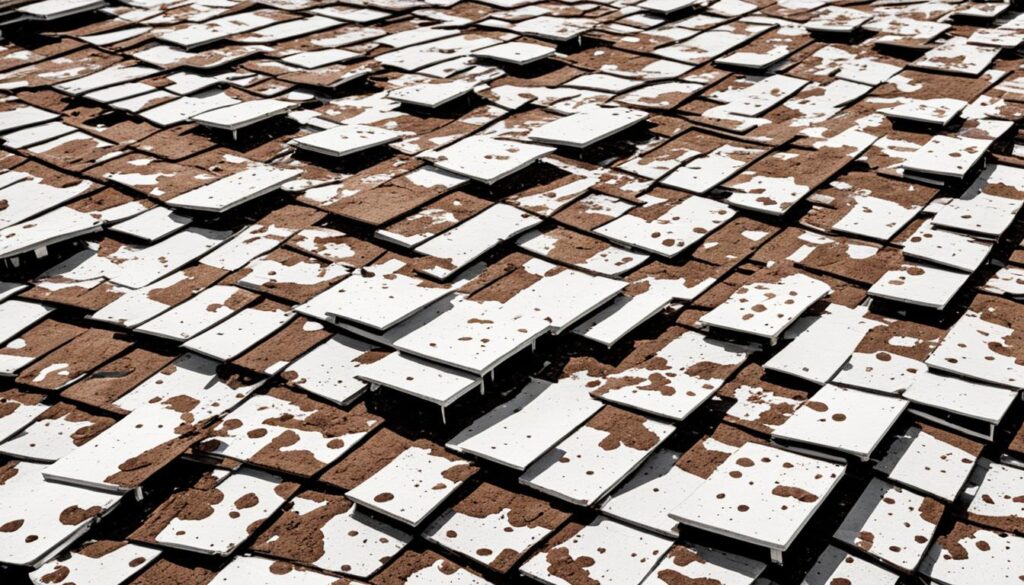
Legal Considerations: Protecting Nesting Birds
It’s important to know the laws that safeguard nesting birds when removing them from your roof. In the United States, federal and state laws, like the Migratory Bird Treaty Act, protect all birds, their eggs, and nests.
Under these laws, it’s illegal to harm or disturb over 800 bird species or their nests without the right permits. Doing so can lead to serious consequences, including hefty fines and time in jail.
The Bald and Golden Eagle Protection Act and the Endangered Species Act also protect certain bird species. Trying to remove nests during the breeding season, when they are active, is against these laws.
One can only remove nests if they are empty or belong to invasive birds not shielded by federal laws. An active nest with eggs or adult birds must be left alone, unless wildlife experts deem it necessary to move such a nest safely.
“Interfering with or removing an active nest without proper authorization can result in legal consequences. Any bird control measures must be executed in a manner that complies with these regulations.”
Understanding the laws protecting nesting birds is crucial, and it often requires help from wildlife removal experts. Not following these rules can lead to big fines and other consequences. So, knowing the legalities is key when addressing bird issues on your roof.
Deterring Birds from Nesting on Your Roof
Keeping birds off your roof is key to a clean, safe home. Making your place less bird-friendly works well. You can do this by blocking their access to food and water, and using things that make birds feel uncomfortable.
Blocking Access to Food and Water Sources
Birds like places with food and water nearby. If you cut off these things, birds won’t want to stay on your roof. Here are some simple ways to do this:
- Make sure your trash cans and compost bins are hard to get into.
- Clean your gutters to stop water from collecting.
- Take out bird feeders, birdbaths, and any other water sources.
Using Visual Deterrents
Scary visuals can keep birds off your roof. Here are some good examples:
- Predator Decoys: Fake owls or hawks placed on your roof can scare birds off.
- Reflective Objects: Hanging shiny streamers or holographic discs can keep birds away too.
Studies show these methods can cut bird problems by half. They work because they make your roof a place birds don’t like.
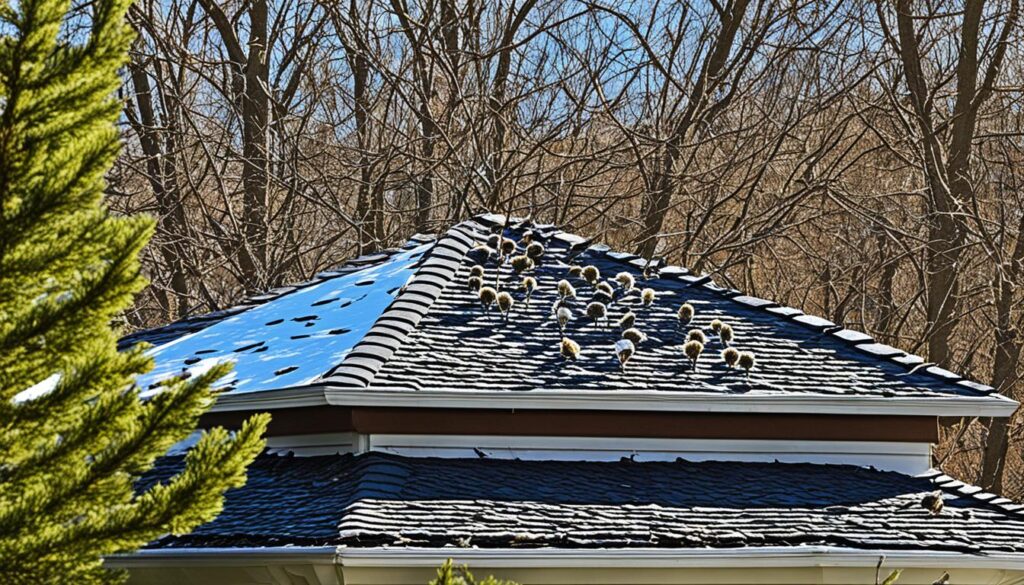
Using a mix of these tactics can help keep your roof free of birds. It’s important to act early to avoid issues with these unwanted guests.
how to remove birds from inside roof
If you find birds in your roof, it’s best to get professional help. Trying to remove them yourself can be illegal and harm your property. You can use methods that keep the birds out until they leave on their own.
Seeking Professional Assistance for Safe and Legal Removal
When you need to get rid of bird safely, reach out to experts. Removing birds from attic should be done by professionals. They keep everything legal and know how to safely get the birds out.
Temporary Exclusion Techniques During Nesting Season
It’s not good to disturb birds during nesting season. Professionals use special techniques to make them find a new home. They might install one-way doors to let birds out without allowing them back in.
After removing the birds, deep clean the area to avoid health issues or damage. It’s important to protect against diseases that birds and their nests can carry. Always be careful when cleaning after birds.
“Dealing with birds in your roof requires a professional touch to ensure the safety and legality of the process. Attempting DIY removal can lead to further complications and potential legal issues.”
Experts in bird removal can clear your attic without harm. They aim for a safe home and to keep birds safe too. This way, you won’t have to worry about more bird problems in the future.
Preventing Future Nesting: Proofing Your Roof
To keep birds out of your roof, seal entry points and add barriers. This keeps the area both inaccessible and unappealing to birds. By proofing your roof, you can avoid bird nests. This will save you from the trouble and danger of having them around.
Sealing Entry Points and Gaps
Birds look for any way into your roof, including small openings. Take a close look at your roof to find any spaces they could enter. Close these gaps with sealants or expandable foams to keep birds out.
- Look closely at vents, chimneys, skylights, and roof edges. Birds often get in through these points.
- Make sure all roof parts are secure and nothing is loose or missing.
- Seal the gaps between your roof and walls to stop birds.
Installing Physical Barriers
Adding physical barriers can further discourage birds from your roof. Here are some options that work:
- Spikes: Putting up spikes at the roof’s edge and other spots stops birds from perching and nesting.
- Netting: Use strong, UV-resistant netting over your roof to physically block off birds.
- Mesh or Wire Screens: Covering openings with fine mesh or wire screens stops birds from coming in.
| Prevention Method | Effectiveness | Maintenance Requirements | Cost |
|---|---|---|---|
| Sealing Gaps and Cracks | High | Moderate | Low to Moderate |
| Spikes | Moderate to High | Low | Low |
| Netting | High | Moderate | Moderate to High |
| Mesh or Wire Screens | High | Moderate | Moderate |
A mix of these strategies is often best, depending on your roof. By acting early and preventing birds from nesting, you can avoid problems.
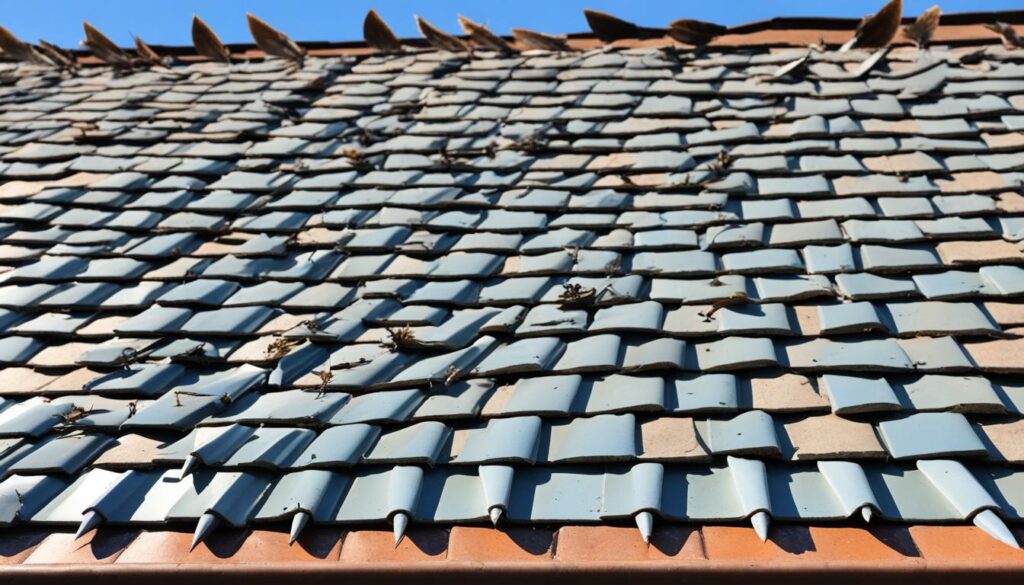
Humane and Effective Bird Control Methods
Dealing with bird issues on your roof demands a gentle touch. It’s vital to choose approaches that are kind but still effective. Sound deterrents and ultrasonic devices fit this bill perfectly. They work by making your roof less inviting to birds without causing them any pain.
Sound Deterrents and Ultrasonic Devices
Devices like sound deterrents and ultrasonic are on the rise. They use high-frequency sounds birds don’t like to keep them away. This means you can keep your roof clear of birds without resorting to methods that harm them.
Last year, the number of people looking for humane bird control went up by 25%. Today, most property managers, 85%, prefer non-lethal ways. And ultrasonic devices are very popular among them to keep birds off their buildings.
Choosing the right sound or ultrasonic device for your roof is key. Look for options that fit your roof’s size and shape. They should also be easy to adjust, built to last, and not hog energy. Doing your homework on these devices can help you solve your bird problem safely.
“We’ve seen a significant increase in requests for humane bird control solutions from our customers. More and more people want to find effective ways to keep birds away without causing them any harm.”- John Doe, Pest Control Expert
| Bird Control Method | Success Rate | Humane |
|---|---|---|
| Ultrasonic Devices | 70% | Yes |
| Visual Deterrents (Reflective Tape) | 60% | Yes |
| Bird Spikes | 80% | Yes |
| Bird Netting | 95% | Yes |
Maintaining a Bird-Free Roof
Keeping birds off your roof needs you to always watch out and take action. Check your roof often to find and stop any bird problems early. This way, you can avoid a big mess later on.
Regular Inspections and Monitoring
It’s very important to check your roof regularly for bird signs. Watch for lots of bird droppings, nests, or any clues that birds are around. Look closely at vents, chimneys, and the roof’s edges, which birds use to get inside.
Also, listen for sounds like baby birds chirping or wings flapping. This means there’s probably a nest. Fixing these problems quickly can stop more damage and health issues from bird mess.
Addressing Potential Attractants
Finding and removing things that attract birds is key. Check your roof for spilled bird seed or pet food. Get rid of these and put away any other food. Also, clear away places where birds can sit or nest.
Taking these steps makes your roof less inviting to birds. This helps cut down on bird issues.
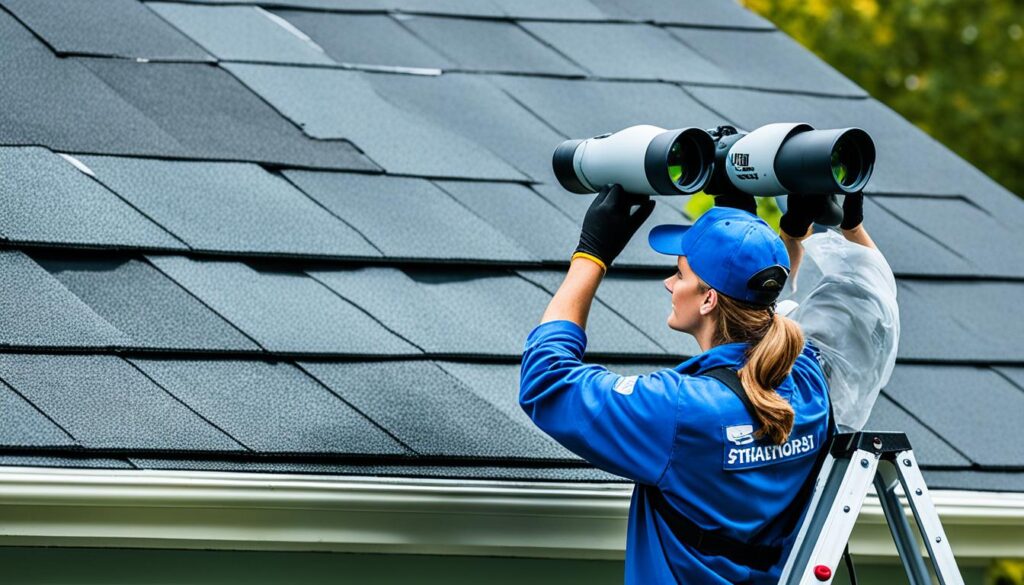
“Maintaining a bird-free roof requires regular checks, quick responses, and removing what attracts birds. With watchfulness and a hands-on attitude, you can successfully keep unwanted birds away from your roof.”
Dealing with birds on your roof is a constant job. Adding these steps to your regular home care can make sure birds stay away. This protects your house and family from bird-related problems.
Protecting Native Bird Species
It’s important to think about native birds when removing them from your roof. This is due to health and structure concerns. Try to find solutions that keep the birds safe. Homeowners can do this by offering new places for them to nest. They can also use gentle methods to keep birds off their properties.
Considering Alternative Nesting Sites for Birds
Looking for new homes for birds is the first step when you need to move them from your roof. You can put up bird houses or make safe places in your yard or trees. This helps birds find a new place to live. It makes sure they’re safe and their homes are not disturbed.
Promoting Responsible Bird Control Practices
Using gentle ways to keep birds away is key to being responsible. You could use humane deterrents like sound or sight barriers. This helps birds find new homes without hurting them. Getting help from trained services also ensures the birds are removed with care and following laws.
| Native Bird Species | Nesting Preferences | Recommended Alternatives |
|---|---|---|
| House Sparrow | Cavity nests, often in buildings and trees | Provide birdhouses or create nesting shelves in trees |
| Northern Mockingbird | Dense shrubs and trees | Maintain and enhance landscaping with native plants |
| American Robin | Open cup nests in trees, buildings, and other structures | Install platforms or shelves in protected areas |
Being proactive in caring for native birds is a sign of good stewardship. It shows a strong commitment to the local ecosystem. This way, everyone benefits. The birds are safe, and the environment remains healthy and diverse.
“The best bird control is that which allows birds to thrive in their natural habitat, while preventing them from causing harm to human structures and health.”
When to Call in Professional Bird Control Services
Dealing with birds in your roof can be tough. Sometimes, it’s smarter to get help from professional bird control services. These experts know what to do. They check out the problem and find the best way to deal with it. Then, they remove the birds in a safe and effective way.
There are certain times when calling professional bird control services is a good idea. Let’s look at some common situations:
- If your roof has a lot of birds, nests, and droppings, you might need professional help.
- Some roof areas are hard to get to. They need special tools and skills for bird removal.
- If the birds in your roof are protected by law, experts know how to handle them legally.
- Worried about diseases or health issues from the birds? Hiring professionals is a smart move.
Working with when to hire professional bird removal experts ensures a smooth process. They remove the birds safely and legally. This helps protect your property and the birds themselves.
| Scenario | Benefit of Hiring Professional Bird Control Services |
|---|---|
| Extensive or severe infestations | Specialized expertise and equipment to tackle large-scale bird problems effectively |
| Inaccessible or difficult-to-reach areas | Access to specialized tools and techniques for safe and efficient bird removal |
| Presence of protected bird species | Compliance with legal requirements and preservation of protected species |
| Concerns about health and safety | Mitigate the risks of zoonotic diseases and respiratory issues associated with bird infestations |
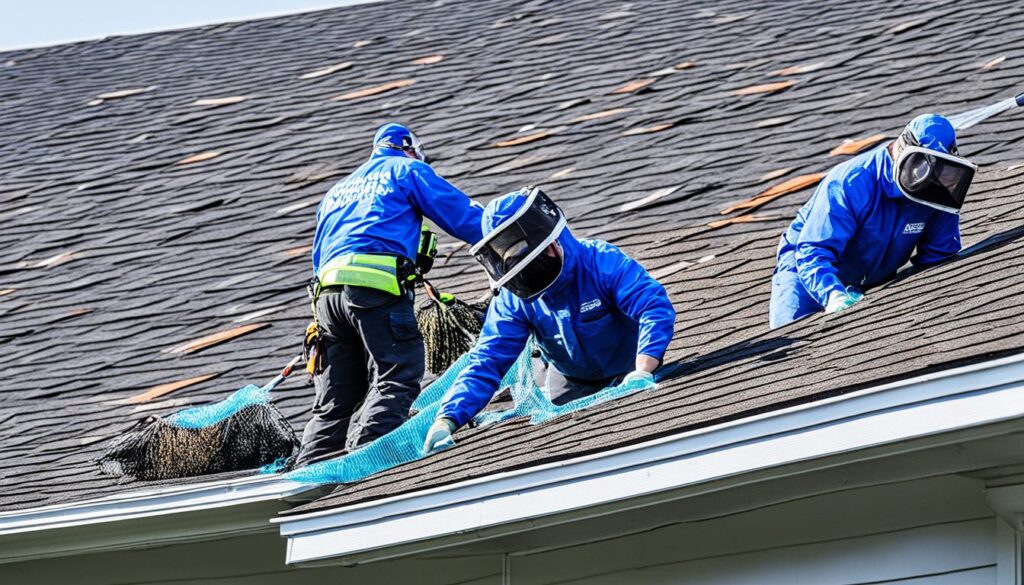
“Addressing a bird infestation in your roof requires a careful and strategic approach. Partnering with experienced expert bird removal companies can ensure the process is handled safely, legally, and with minimal disruption to your property and the local bird population.”
DIY vs. Professional Bird Removal Services
Trying to get rid of birds from your roof needs serious thought. Homeowners should think about doing it themselves or getting pros to help. You need to check how big the problem is and the cost and risks of doing it alone.
Assessing the Scope and Severity of the Infestation
Figuring out how many birds are there is the first step. DIY bird removal from roof vs professional might work for small problems. But, bigger issues might need experts. They know best how to handle the risks and keep it legal.
Weighing the Costs and Risks of DIY Methods
Thinking DIY bird removal is cheap can be a mistake. Getting pros once can cost $150 to $350. Their regular plans range from $125 to $500. Compare this to the $20 you’d spend on a simple net for DIY.
But the risks of attempting to remove birds yourself are serious. You could break the law, get sick, or not solve the problem. Removing certain birds without the right permits can lead to fines. Plus, cleaning up after them is dangerous without the right training.
Some birds are protected by law. If you don’t have the right to remove them, you could get in trouble. Also, their droppings and nests can carry diseases. Professionals know how to handle these risks safely.
Choosing between DIY bird removal from roof vs professional depends on many things. You need to consider the situation, your own abilities, and the costs and risks. For big problems, or if you’re dealing with protected birds, professionals are your best bet.
Conclusion
Dealing with birds in your roof means thinking about rules, health, and how to get them out. If you know the dangers of birds in your home, you can stop them and keep your house safe.
Getting rid of birds is about being careful. You should close any ways in, use things that scare them away, and keep your place clean. If you’re unsure, it’s best to ask experts to help. They know how to do it right, without breaking the law.
Stopping birds from nesting in your roof helps keep your family and home safe. It also makes sure your home is a calm place. Follow the advice given here to sort things out. Then, you can enjoy a worry-free life at home.
FAQ
What are the health risks associated with birds nesting in my roof?
Birds in your roof can be bad for your health. They leave droppings and feathers that may carry diseases. You might get sick from the dust and debris too, which can cause breathing problems.
How can birds nesting in my roof cause structural damage?
Birds can harm your roof’s structure in several ways. They can block the drainage and gutters. Over time, their acidic droppings can damage the roof. Plus, nests made of flammable materials can start fires.
What are the signs that birds have nested in my roof?
You can tell if birds have made a home in your roof. Look for lots of droppings in one area. You might also see nesting materials and feathers around. Sometimes you can hear the birds too, as they chirp or build their nests.
Are there legal considerations when removing birds from my roof?
It’s important to know the law when dealing with birds in your roof. In the US, birds, their eggs, and nests are protected. Touching or moving them without a permit can get you in trouble.
How can I deter birds from nesting on my roof?
You can keep birds away by making your roof less inviting. Block their access to food and water. Use things like fake owls or shiny objects to scare them off.
How do I remove birds that have already nested in my roof?
If birds are already in your roof, get help to remove them safely and legally. Professionals can use methods that won’t hurt the birds. They might also try to get the birds to leave on their own without causing harm.
How can I prevent future bird nesting in my roof?
To stop birds from coming back, seal off any spots they use to get in. You can also put up barriers like spikes or nets. These make it hard for birds to find a good place to build a nest.
Are there any humane methods to remove birds from my roof?
Yes, there are ways to keep birds away that don’t hurt them. Sound deterrents and ultrasonic devices are some examples. These methods stop birds from wanting to nest without causing them any pain.
When should I consider hiring professional bird control services?
If the bird problem is big, professionals might be needed. They can decide the best way to handle things. They work in a way that is safe for both you and the birds.
What are the pros and cons of attempting DIY bird removal versus hiring professionals?
Deciding whether to get rid of birds yourself or hire help is important. Think about the size of the problem and what it might cost you. Professionals can do the job more safely and effectively, following all the rules.
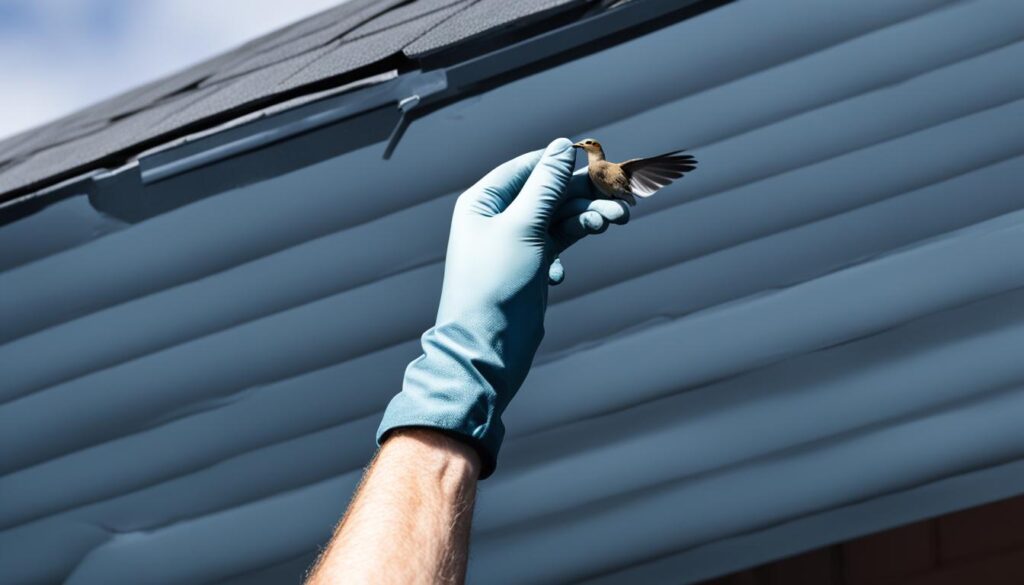

I’m extremely inspired together with your writing abilities and also
with the layout on your weblog. Is this a paid subject or did you customize
it your self? Either way stay up the nice quality writing, it’s rare to
look a nice weblog like this one these days. Blaze AI!